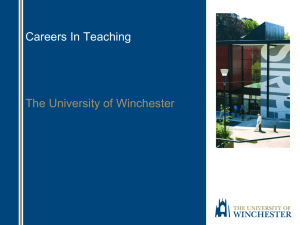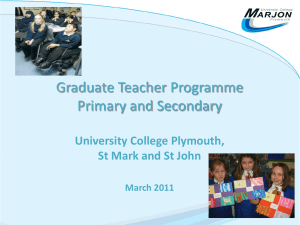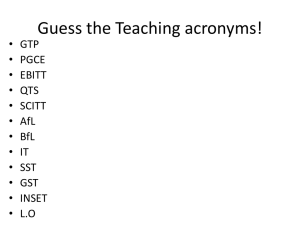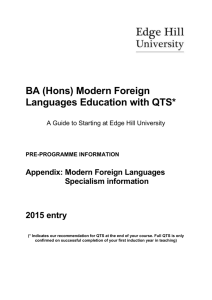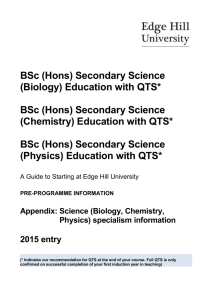pathways into teaching in england
advertisement
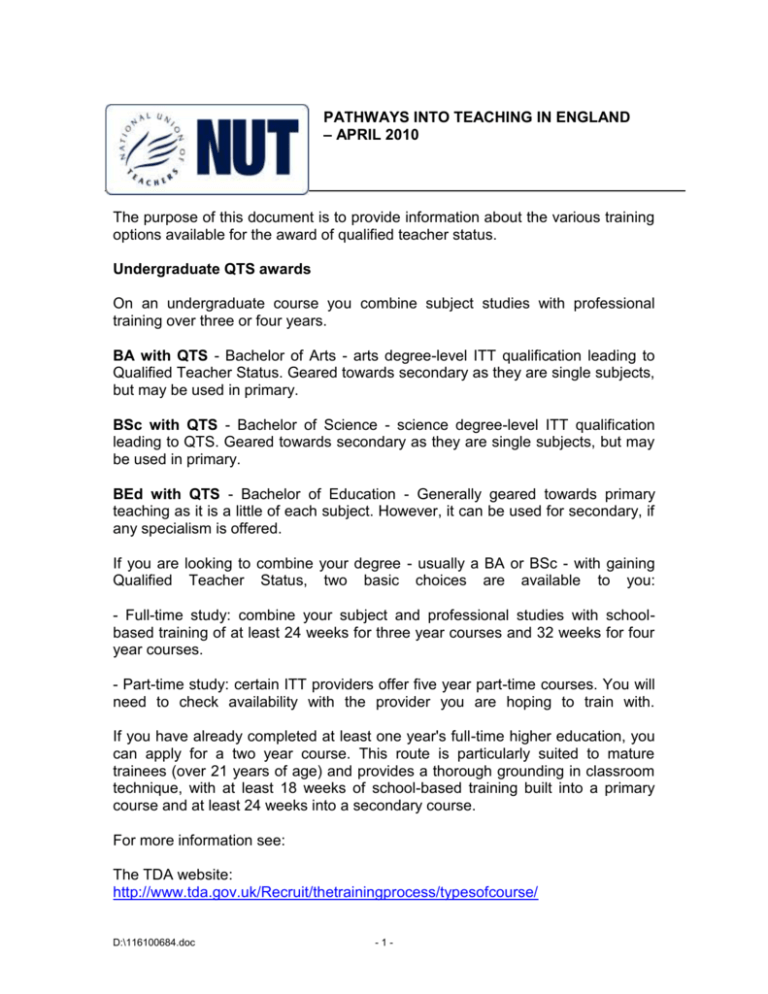
PATHWAYS INTO TEACHING IN ENGLAND – APRIL 2010 The purpose of this document is to provide information about the various training options available for the award of qualified teacher status. Undergraduate QTS awards On an undergraduate course you combine subject studies with professional training over three or four years. BA with QTS - Bachelor of Arts - arts degree-level ITT qualification leading to Qualified Teacher Status. Geared towards secondary as they are single subjects, but may be used in primary. BSc with QTS - Bachelor of Science - science degree-level ITT qualification leading to QTS. Geared towards secondary as they are single subjects, but may be used in primary. BEd with QTS - Bachelor of Education - Generally geared towards primary teaching as it is a little of each subject. However, it can be used for secondary, if any specialism is offered. If you are looking to combine your degree - usually a BA or BSc - with gaining Qualified Teacher Status, two basic choices are available to you: - Full-time study: combine your subject and professional studies with schoolbased training of at least 24 weeks for three year courses and 32 weeks for four year courses. - Part-time study: certain ITT providers offer five year part-time courses. You will need to check availability with the provider you are hoping to train with. If you have already completed at least one year's full-time higher education, you can apply for a two year course. This route is particularly suited to mature trainees (over 21 years of age) and provides a thorough grounding in classroom technique, with at least 18 weeks of school-based training built into a primary course and at least 24 weeks into a secondary course. For more information see: The TDA website: http://www.tda.gov.uk/Recruit/thetrainingprocess/typesofcourse/ D:\116100684.doc -1- The University and Colleges Admissions Service website: http://www.ucas.com/ Postgraduate QTS awards For entry to postgraduate Initial Teacher Training, you will need a relevant degree or equivalent qualification. For primary teaching, it is often an advantage to have a degree related to the National Curriculum. For those wishing to specialise in early years teaching, a degree in early childhood studies can be a suitable preparation for teaching. For secondary teaching most ITT providers require a degree in the subject to be taught or a closely-related one. It usually takes a year to complete a postgraduate ITT programme and to achieve Qualified Teacher Status, although you may be able to extend or shorten the length of your training to suit your particular needs and circumstances. Generally, at least 18 weeks of the year are spent in school if you are pursuing primary school teaching, or 24 weeks for secondary. In either case, you'll be trained by both school-based and higher education tutors. Usually, secondary teachers specialise in teaching the subject they have been studying at university, but you can opt to take a short intensive subject support course prior to the start of ITT to acquire the additional subject knowledge you need. Some ITT providers may take the view that your degree contains enough subject-based knowledge and will accept you onto the course on this basis. A few ITT providers offer full-time ITT over two years to give you time to study additional subjects - usually secondary subjects such as design and technology, mathematics, modern foreign languages and science. For more information see: The TDA website: http://www.tda.gov.uk/Recruit/thetrainingprocess/typesofcourse/pgce.aspx The Graduate Teacher Training Registry website: http://www.gttr.ac.uk/ School-Centred Initial Teacher Training You can decide to train in a school full-time. School Centred Initial Teacher Training (SCITT) in England offers full-time school-based training through which you acquire skills and knowledge in a classroom environment. The training is run by the schools, sometimes with input from Higher Education institutions and Local Authorities (LAs). In these programmes, your main base and tutors will be D:\116100684.doc -2- in a school, although on most SCITT programmes you will also have tutors from the school’s partner Higher Education institution. A School-Centred Initial Teacher Training group is made up of secondary and/or primary schools (maintained or independent sectors) in England. Groups are accredited by the Training and Development Agency for Schools (TDA) to run courses of initial teacher training. All courses lead to Qualified Teacher Status for students upon successful completion and may also lead to a PGCE validated by an HE institution. For more information see: The TDA website: http://www.tda.gov.uk/Recruit/thetrainingprocess/typesofcourse/scitt.aspx The Graduate Teacher Training Registry website: http://www.gttr.ac.uk/ Flexible routes Flexible ITT programmes are designed to enable people who are not able to train full-time on a traditional postgraduate course to access training that matches their individual needs and circumstances. The training takes account of your prior learning and achievement. Courses have multiple start and finish dates. You may wish to undertake modules in the evening or weekends, via distance-learning packages, or alternatively you may wish to undertake an intensive full-time programme over a short time. Those with significant teaching experience may also be able to follow an assessment-only route to QTS. Flexible routes are available to any eligible graduate - those in employment looking for a change of career, graduate classroom assistants and experienced teachers without QTS as well as recent graduates. Those with qualifications acceptable for a Postgraduate Certificate of Education are eligible to apply for this training. ITT providers may have additional selection criteria. Those who already have teaching experience e.g. overseas as a teacher, worked as a trainer in industry, or taught in the further education or independent sector without gaining QTS, may already be able to demonstrate that they meet some of the Standards for the Award of QTS, so their training programme may not need to include training relating to these Standards. Consequently, their training programme could be much shorter than other postgraduate ITT routes. Some candidates may need no further training, and many of the training providers offer an assessment-only route to QTS, allowing candidates to more quickly demonstrate they meet the necessary Standards. For more information see: D:\116100684.doc -3- The Graduate Teacher Training Registry website: http://www.gttr.ac.uk/ The Graduate Teacher Programme The Graduate Teacher Programme (GTP) enables schools to employ people who are not yet qualified to teach and train them through an individual training programme leading to QTS. The programme is particularly popular with people who want to change to a teaching career and need to continue earning while they train. The training is tailored to suit individual needs. The GTP involves one year of postgraduate training. You must have a first degree to be eligible to apply. The school will pay you at the rate of a qualified or unqualified teacher. The TDA pays a grant to cover the cost of your training and may also pay the school a contribution towards your salary of up to £13,000 per year. Entry to the GTP is highly competitive with places going to the best applications in priority funding categories. You must be 24 years old or more to apply for the Graduate or Registered Teacher Programmes, unless you have already qualified as a teacher overseas. For more information see: The TDA website http://www.tda.gov.uk/Recruit/thetrainingprocess/typesofcourse/gtp.aspx The Registered Teacher Programme The Registered Teacher Programme (RTP) offers you a way to qualify as a teacher while you work. When you have found a job in a school as an unqualified teacher, you can follow an individual training programme leading to QTS. At the same time you complete your degree. Once you have QTS, you can work as a qualified teacher in any maintained school in England. The programme suits people who want to change to a teaching career and need to continue earning while they train. The training is tailored to suit your individual needs. The RTP is a challenging route. It takes effort and commitment to work and train in a school, and study for your degree at the same time. To be eligible for the RTP, you must have successfully completed two years of equivalent) in mathematics and English. For primary, you must have GCSE grade C or above (or equivalent) in science. If your qualification is equivalent to two years of higher education and a university would accept you on a top-up degree programme you may be eligible for the RTP. D:\116100684.doc -4- The programme normally lasts two years. The minimum length of a programme is twelve months. For more information see: The TDA website: http://www.tda.gov.uk/Recruit/thetrainingprocess/typesofcourse/rtp.aspx The Overseas Trained Teacher Programme If you are already qualified as a teacher in another country and want to work as a qualified, permanent teacher in England or Wales, you need to have Qualified Teacher Status (QTS) and be registered with the General Teaching Council for England or Wales. Teachers from within the European Economic Area (EEA) may have teaching qualifications which are transferable, so you can gain QTS without further training. The Overseas Trained Teacher (OTT) Programme is available for those who have overseas teaching qualifications which are not recognised in England. Trainees follow an individual training programme designed to enable them to meet the standards for the award of QTS, whilst at the same time working as an unqualified teacher in a school. Overseas teachers may work as a temporary teacher without QTS for up to four years. This time period commences on the day you first worked as a teacher in England and expires either four or two years later, regardless of any breaks in teaching and irrespective of your immigration status. You may not continue teaching after this period has expired if you have not obtained QTS. For more information see: The TDA website: http://www.tda.gov.uk/Recruit/thetrainingprocess/typesofcourse/ottp.aspx Teachernet: http://www.teachernet.gov.uk/teachinginengland/ The National Academic Recognition Centre: http://www.naric.org.uk/ Teach First After being admitted to the programme, trainees complete one week of observation in a school of their choice. They then attend a summer training D:\116100684.doc -5- programme, which commences in late June and lasts six weeks. Trainees are placed in schools with approximately three other participants. In their first year, trainees follow a programme which is very similar to the Graduate Teacher Programme (GTP). They are employed as unqualified teachers in the same way as GTP trainees. In addition to school-based mentors, however, they receive support from Teach First tutors and mentors. At the end of the first year, they are expected to gain Qualified Teacher Status (QTS). The second year of the programme is the induction year. Participants are expected to meet the Induction Standards by the end of the second year. They will also receive tailored mentoring, training and internships with sponsors, including training for a Foundations of Management certificate. Once they have gained QTS (start of the second year), they are transferred to the qualified teachers’ pay scale. For more information see: The TDA website: http://www.tda.gov.uk/Recruit/thetrainingprocess/typesofcourse/teachfirst.aspx The Teach First website: http://www.teachfirst.org.uk/ The Fast Track Scheme From 1 September 2005 Fast Track was refocused as a leadership development programme and no longer recruits teacher trainees. The programme now concentrates on the professional development opportunities and support available for Fast Track teachers, to ensure that Fast Track teachers achieve senior leadership positions within four to five years. For more information see: The National College for School Leadership website: http://www.ncsl.org.uk/programmes/fasttrack/ D:\116100684.doc -6-
